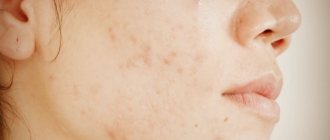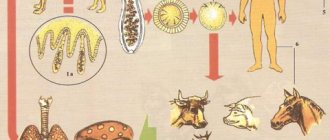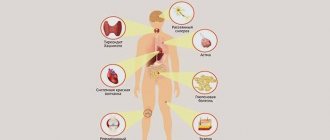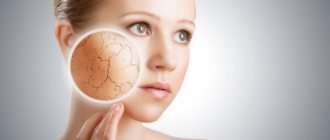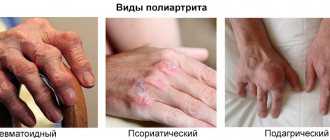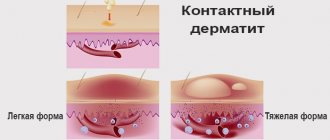Causes of pyoderma
Pyoderma or skin pyodermitis is a pustular disease of the epidermis. It occurs during the invasion of pathogenic microorganisms, which trigger a local inflammatory process with the formation of pustules filled with a cloudy white liquid.
Causative agents of pyoderma:
- Staphylococcus. A bacterium that enters the body through damaged skin. Staphyloderma often develops against the background of immunodeficiency due to a violation of the body's defenses.
- Streptococcus. A microorganism that differs in biochemical characteristics from the previous representative causes pyoderma more often on the human face.
More than 50% of clinical cases are caused by more than one pathogen. There is a combination of several microorganisms that simultaneously provoke inflammation in the affected area. To combat infection, you need to use medications that affect the identified types of bacteria in a particular case.
Factors provoking pyoderma:
- Acquired or congenital immunodeficiency.
- Minor mechanical damage to the skin.
- Chronic diseases of internal organs.
- Metabolic disorders - diabetes, gout.
- Ignoring personal hygiene rules.
- Stress.
- Unbalanced diet.
- Excessive workload without adequate rest.
Therapeutic cosmetics La-Cri for children with staphyloderma
Children's skin is especially vulnerable because its protective functions have not yet developed like those of an adult. During and after staphyloderma, the epidermis suffers even more, so during this period it is especially important to switch to hypoallergenic care products.
La-Cri natural cosmetics enjoy an excellent reputation among pediatricians and parents. The series of products for the care of children's and sensitive skin includes creams, gels and emulsions.
La Cree soft gel for face and body is ideal for cleansing vulnerable skin. It is designed specifically for skin prone to redness, itching and irritation and is suitable from the first days of life. This gel gently cleanses and restores the skin thanks to the presence of medicinal plant extracts, avocado and olive oils. There are no parabens, hormones or other harmful chemicals in La Cree cosmetics.
After washing, it is advisable to apply cream for sensitive skin. It effectively relieves itching, fights inflammation and flaking. The parsley extract included in the composition helps reduce rashes, while violet extract and bisabolol soothe the skin. In addition, the cream contains panthenol, which accelerates skin regeneration. Walnut extract improves wound healing and fights germs.
Is pyoderma contagious?
Yes, the disease can spread between patients if they are in constant contact. Bacteria are transmitted from one person to another by shaking hands or using shared hygiene products.
More often, the spread of microorganisms occurs in children's groups, where children share toys. Identification of an infected child is the reason for his temporary isolation and appropriate recovery.
But getting infected does not mean getting sick. The state of the immune system influences the outcome of bacteria entering the body. Microorganisms are normally present on human skin, but due to the activity of natural barriers they do not cause symptoms. Dysfunction of protective forces leads to progression of the disease.
Pyoderma in adults and children can be primary or secondary. In the absence of diseases of the internal organs and a person is infected directly through damaged skin, doctors talk about an independent pathology. Secondary pyoderma develops against the background of diabetes, gout, and other diseases and is rarely transmitted to people.
Therapeutic drugs for staphyloderma in children
The doctor selects antibacterial drugs for the treatment of staphyloderma based on laboratory tests that show which active components of the drug the bacteria are sensitive to. In each case, a certain antibiotic helps to achieve a positive effect, so never try to treat the disease and select the drug yourself. Strictly follow the recommended dosage and duration of use. Do not violate prescribed treatment regimens.
In most cases, antibacterial drugs from the group of penicillins, cephalosporins and macrolides are used in the treatment of various forms of staphyloderma. For local treatment, antibiotic ointments are rubbed into the lesions, after wiping the skin with salicylic alcohol. The skin around the ulcers is treated with antiseptics.
To improve the general condition in the treatment of childhood staphyloderma, immunomodulatory drugs are used, which strengthen the body's defense system and its resistance to disease. Vitamins and minerals and physical therapy are also prescribed for tissue restoration and healing. Treatment procedures are carried out in courses - from 7 to 10 days. The duration of treatment is determined taking into account the form and stage of the disease. Sometimes physical therapy is repeated. Most often, ultrasound and laser therapy are used in the physiological treatment of manifestations of staphyloderma.
In severe cases, the abscesses are opened surgically using a sterile medical needle. The lesions are treated with antiseptics.
Since antibacterial therapy can negatively affect the intestinal microflora, children are often prescribed biological products to restore it.
It is very important to monitor the child’s nutrition during treatment for staphyloderma. During this period, it is worth excluding fried and smoked foods, marinades, spices, and limiting salt. If your doctor recommends a certain diet and menu, you should adhere to these recommendations.
Symptoms of pyoderma
Strepto- and staphylococcal pyoderma develops according to the same pattern:
- The bacterium penetrates the layers of the epidermis and begins to secrete exotoxins.
- To neutralize the microorganism, leukocytes and macrophages are sent to the pathological area - cells that neutralize foreign bodies.
- Due to massive infestation or weakened immunity, bacteria are not destroyed. Small blisters (phlyctenas, pustules) with purulent contents form.
- Nonspecific symptoms of intoxication progress.
The clinical picture of the disease depends on the location of the skin lesion.
General symptoms of pyoderma:
- The appearance of pustular elements on the corresponding area of the skin.
- Itching or pain in the affected area.
- Redness.
- Local increase in temperature. Sometimes, with massive skin lesions, fever progresses.
- Weakness, fatigue.
- Formation of erosions, ulcerations.
The streptococcal or staphylococcal form of bacterial infection of the facial skin is additionally accompanied by a visual defect, which causes moral discomfort for the patient.
The combination of coccal flora with fungi or bacteria is accompanied by the appearance of additional symptoms. A film may appear over the affected areas, and allergy symptoms develop in parallel.
Regression of the disease is accompanied by a gradual decrease in the number of pathological skin elements. At the sites of pustules, zones of increased pigmentation and peeling are formed, which disappear without a trace within 1-3 weeks.
Clinical researches
Conducted clinical studies prove the high efficiency, safety and tolerability of products for daily skin care of children with mild and moderate forms of atopic dermatitis and during remission, accompanied by a decrease in the quality of life of patients.
In the course of research conducted by the Union of Pediatricians of Russia, it was found that La-Cree cream for sensitive skin:
- reduces itching and irritation;
- relieves skin redness;
- moisturizes and gently cares for the skin.
Forms of pyoderma
Pyoderma is a complex of symptoms that progresses differently in patients. Depending on the nature of the course, the following forms of the disease are distinguished:
- Spicy. The duration of the process is limited to two months and severe clinical symptoms.
- Chronic. The skin lesion lasts more than 2 months, the symptoms are erased.
Depending on the depth of damage to the layers of the skin, it happens:
- Superficial pyoderma. The disease progresses favorably and is amenable to drug treatment.
- Deep pyoderma. The disease is characterized by a severe course with fever. Pathology requires the use of medications from different groups.
Pustular skin lesions can be localized and distributed throughout the body. Facial pyoderma and carbuncle on the neck are an example of the first group of diseases.
Depending on the pathogen that causes the disease, pyoderma can be staphylo-, streptococcal or mixed. Each group consists of separate types of skin lesions.
Staphylococcal pyoderma
- Folliculitis is inflammation of the hair follicle.
- Sycosis is a common form of folliculitis, which is characterized by the simultaneous presence of pathological elements at different stages of development. The problem occurs in men in the mustache area (facial pyoderma).
- Epidemic pemphigus of newborns is a disease that affects children 7-10 days old. The pathology is manifested by the formation of numerous blisters on the child’s skin, which hurt and constantly disturb the baby.
- A furuncle is an inflammation of the hair follicle, which is accompanied by necrotic changes in nearby tissues.
- Carbuncle is a pathology that leads to necrosis and purulent melting of an area of skin with an underlying fatty layer. After the dead tissue is rejected, a deep ulcer appears, which heals with the formation of a scar. Read more about carbuncle →
- Hidradenitis is an inflammatory process in the sweat glands. The pathology is most often localized in the armpits. Read more about hidradenitis →
Streptococcal pyoderma
- Vulgar impetigo is the formation of many blisters (conflicts) on the head, along the patient’s body, in the nail area, and in the corners of the mouth. Symptoms are minimal.
- Vulgar ecthyma is a deep form of streptoderma. It occurs with the formation of a phlyctena, which ruptures into an extensive ulcer.
Development mechanism
Pyoderma is a contagious disease, that is, it can be transmitted through direct contact from a sick person to a healthy person.
Depending on the type of pathogen, this occurs as follows:
- Staphylococcal infection spreads by contact - through hands, clothing, dishes, household items,
- Streptococcal infection in 95% of cases is transmitted by airborne droplets, since the pathogen is located mainly on the mucous membranes of the upper respiratory tract.
The incubation period can last from 3 to 10 days. The mechanism of development of pyoderma has two main forms:
- Primary - occurs on intact healthy skin.
- Secondary - is a complication of other diseases (heat rash, eczema, scabies).
Infection of newborn children is possible in utero if the expectant mother has suffered an infectious disease, or after childbirth through contact with sick people and infected objects.
Diagnostics
Correct diagnosis is the key to successful treatment. Pyoderma is a group of diseases that can be easily identified. While communicating with the patient, the doctor studies and analyzes:
- Complaints.
- History of the disease.
- Having contact with an infected person. The disease can be transmitted even without direct communication with the patient; it is enough to use his individual belongings.
By visually assessing the rash, the doctor makes a preliminary diagnosis. To confirm the guess, the doctor prescribes additional procedures.
Ancillary diagnostic examinations:
- General blood analysis. An increase in the number of cells responsible for inflammation (leukocytes) remains characteristic.
- Sowing the contents of the vesicles to identify the pathogen.
- An antibioticogram will be able to determine the most effective drug.
In the case of combined pathology, consultations with related specialists are carried out using appropriate diagnostic procedures (X-rays, ultrasound, etc.).
Traditional medicine for staphyloderma
Traditional medicine helps to enhance the effect of the main treatment of staphyloderma. For example, herbal decoctions and infusions of medicinal herbs that are rubbed into lesions. Infusions of chamomile, plantain, St. John's wort and sage help dry out inflammation, reduce itching and pain.
Also, inflamed parts of the skin are wiped with blackcurrant and blackberry juice, and lubricated with aloe juice. In addition, during staphyloderma, a bath with herbal decoctions helps to achieve a positive result.
However, it is important to consult a dermatologist before using such products. In some cases, the use of decoctions and infusions is contraindicated and can lead to complications.
Treatment of pyoderma
How to treat bacterial skin lesions? To correct the patient’s condition and eliminate symptoms, an integrated approach is used, which is based on the severity of the pathology and the form of the specific disease.
To treat pyoderma, specific drugs are used that directly affect the pathogen:
- Strepto- and staphylococcal toxoids.
- Antifagin.
- Bacteriophages are viruses that destroy pathogenic microorganisms.
- Antistaphylococcal immunoglobulin.
The use of antibiotics for pyoderma is an effective method of neutralizing the pathogen in mixed infections. Preference is given to agents with a broad spectrum of action - penicillins, cephalosporins, aminoglycosides.
Treatment of pyoderma with local damage to the superficial layers of the skin begins with the application of topical antiseptic and antibacterial drugs. Remain popular:
- Fukortsin.
- Salicylic alcohol.
- Ichthyol.
- Tetracycline and erythromycin ointment.
Carbuncle, furuncle and hidradenitis are subject to surgical dissection with further drainage. Drug treatment of pyoderma is the second stage of the patient’s recovery.
Traditional medicine in the treatment of bacterial skin lesions refers to auxiliary methods. Natural recipes are aimed at nonspecific strengthening of immunity or reducing the aggressiveness of the pathogen.
Treatment of pyoderma at home
Popular folk remedies:
- A decoction of birch buds in the proportion of 100 ml of boiling water per 15 g of dry raw materials. The skin is washed with the liquid.
- Juice from the fume grass for lotions.
- A mixture of yarrow herb and olive oil in a ratio of 1 to 10 for treating leather.
- A paste of freshly grated beets for applying to pustules.
- Garlic and alcohol for local disinfection.
Treatment at home cannot be used as a basic method of therapy. To prevent the development of undesirable consequences, you must first consult a doctor.
Staphyloderma in children: Treatment
Staphyloderma in children is treated comprehensively, and the treatment methods are practically no different from adult therapy. For this purpose, general and local drugs are used.
Parents should know that staphyloderma cannot be treated on their own. All medications and treatment methods are determined by the doctor based on the diagnosis.
Treatment can last differently for each patient: the duration of therapy is influenced by the patient’s age, his general condition, the form and stage of the disease, and the severity of inflammation. Treatment methods are selected individually in each case. The cause of staphyloderma plays an important role, so dermatologists try to establish it first.
The main goal of therapy is to relieve the symptoms of staphyloderma and normalize the patient’s condition. Treatment is aimed at reducing the activity of androgens, normalizing the functioning of the sweat and sebaceous glands, and destroying harmful bacteria. For this purpose, antibacterial drugs are used: both general and local. The lesions are treated with special ointments and creams.
Need to know!
For treatment of staphyloderma to be effective, local ointments and creams must be used only in conjunction with complex antibiotics and other drugs prescribed by a doctor to relieve symptoms.
Prevention
Prevention of pyoderma is primary, when measures are aimed at preventing the occurrence of the disease in healthy people, and secondary – preventing re-infections.
Timely treatment of wounds, microtraumas, and adherence to personal hygiene rules are means to prevent bacteria from entering the body. Secondary prevention is based on the use of vitamins and physiotherapeutic procedures to strengthen the immune system.
Pyoderma is a common problem that can be treated. The main thing is to consult a doctor in a timely manner and minimize the influence of factors provoking the disease.
There are no similar articles.
Which doctor should I contact?
If signs of pathology are detected, the patient must be isolated, providing him with separate utensils and hygiene products.
To prevent complications from occurring, you should immediately consult a doctor. This group of diseases is treated by a dermatologist, who will conduct an examination and refer you for laboratory tests.
For deep abscesses, such as carbuncle or hidradenitis, surgical intervention is required. The help of this specialist is also necessary for necrotic lesions of the skin and tissue that need to be removed. This occurs in pyoderma gangrenosum suppurativa, which can begin in people with malignant tumors, dysproteinemia, ulcerative colitis and other diseases.
Staphylococcal infection on the face and head
The danger of this infection lies in its resistance to antiseptic and antimicrobial drugs. The infection can affect both children and adults. Staphylococci can affect any organs, causing inflammatory processes.
Purulent lesions form on the skin; due to lack of treatment, they spread to nearby areas and infect them.
The bacterium can cause blood poisoning, which leads to the development of serious pathologies. People with weakened immune systems are most susceptible to infection - the body is not able to independently resist the microorganism.
Complications
Severe consequences of pustular diseases are observed with:
- untimely access to a medical institution;
- weak immunity;
- undergoing an incomplete course of therapy;
- use of questionable treatment methods;
- poor hygiene;
- preservation of provoking factors.
- inflammation of the lymph nodes;
- abscesses;
- scars in areas of self-removal of pustules; infection of bone tissue;
- blood poisoning;
- thrombosis of cerebral vessels;
- meningitis;
- inflammation of internal organs.
Video
Pyoderma is a dermatological disease that occurs under the influence of pyogenic (pyogenic) bacteria. With various forms of pyoderma, the skin becomes covered with ulcers of various sizes.
Rashes, inflammation of the epidermis, redness, itching are the result of the activity of pathogenic microorganisms. Increased proliferation of streptococci, staphylococci, and fungi leads to extensive damage to the skin.
scalded skin syndrome
Drits Irina Alexandrovna. Parasitologist Helminth infections can lead to numerous health problems, shortening life by 15-25 years. Many parasites are extremely difficult to detect. They can be anywhere - in the blood, intestines, lungs, heart, brain. Symptoms of helminthic infestation can be confused with ARVI, gastrointestinal diseases and others. The main mistake in such cases is delay! If you suspect the presence of parasites, you need to contact a specialist. If we talk about medications and self-treatment, then this antiparasitic complex .
After the lesion, a crust appears on the skin, which within 24 hours becomes purple, painful and actively spreads throughout the body. Severe pain may occur, and the skin becomes wrinkled and papery.
Blisters form on the affected areas, leading to erosion. Within three days, the disease can spread to a huge area of the body, significantly worsening a person’s well-being.
scalded skin syndrome
What is the disease
Staphylococcal infection is the infection of the body with Staphylococcus microbes. These can be both mild and complex forms of pathological processes.
During their life, microorganisms produce large amounts of enzymes that are toxic to the body. More often this affects the condition of the skin, less often the functioning of the nervous system.
Streptococcus at 1000x magnification
These microbes are highly resistant to environmental influences and antibiotics.
Classification
The main microorganisms that cause pyoderma are streptococcus (Streptococcus pyogenes) and staphylococcus (Staphylococcus aureus). The percentage of diseases caused by other microflora (pseudomonas or Escherichia coli, pseudomonas infection, pneumococci, etc.) is very small.
Therefore, the main classification according to the nature of the pathogen is divided into:
- staphyloderma - purulent inflammation;
- streptoderma - serous inflammation;
- strepto-staphyloderma - purulent-serous inflammation.
In addition, any pyoderma differs in its mechanism of occurrence:
- primary - manifested on healthy skin;
- secondary - which has become a complication of other diseases (most often accompanied by itching).
In addition, pyoderma is divided according to the depth of infection. Therefore, the general classification of pyoderma looks like this:
- with superficial depth of infection (streptococcal impetigo, syphilide-like impetigo, bullous impetigo, intertriginous impetigo (slit-shaped), annular impetigo, streptococcal impetigo, superficial panaritium, dry streptoderma);
- with deep penetration (acute streptococcal cellulitis, vulgar ecthyma).
Staphyloderma includes:
- with superficial depth of infection (superficial folliculitis, ostiofolliculitis, acne vulgaris, sycosis vulgaris, epidemic pemphigus of newborns);
- with deep penetration (deep folliculitis, furuncle, furunculosis, carbuncle, hidradenitis).
Strepto-staphyloderma includes:
- with superficial depth of infection (impetigo vulgar);
- with deep penetration (chronic ulcerative pyoderma, chancriform pyoderma).
Consumer Reviews
Elmira Isakova (flap.rf)
“We used La Cree cream for atopic dermatitis in a child. Of course, this series is not intended for severe forms, but it relieves mild redness and itching. The smell is very pleasant, fresh.
I myself used the cream a couple of times for mosquito bites. I itched for a long time, couldn’t sleep, but after using the cream the itching went away and I slept peacefully. Many pharmacies have it, the price is average. I recommend!"
tan.-log (otzovik.com)
“I first came across the LA-KRI cream from Vertex when last year in the spring some rashes appeared on my daughter’s face, which seemed to me to be similar to lichen. In a panic, I turned to a dermatologist, but after all the tests, the doctor calmed me down, saying that it was just a skin infection that the child brought to his face with his hands. Salicylic alcohol 1% was prescribed; for decontamination and after wiping with alcohol, it was necessary to apply a layer of LA-KRI cream to the rash. At first I was wary of this product, but the doctor explained that this is a regular cream that contains oils of various herbs, softens the skin well and relieves redness and irritation...
...Area of application of the cream:
- Diaper rash in children, and in adults too))) - copes with them easily
- sunburn - personally tested - really brings relief
- insect bites - relieves itching from mosquito bites (also tested on myself)
The consumption of the cream can be said to be economical. My family has been using a 30g tube for a year now and it’s not going to run out yet. I don’t remember the exact price, but I think it cost 120-130 rubles a year ago. Now a tube of LA-CREE cream is always in my medicine cabinet. Try it, you won’t regret it.”
What is the danger?
Pyoderma in children does not always occur without consequences. Significant skin lesions cause general intoxication of the body, fever, loss of appetite and breast refusal, and developmental delay. Pyoderma is especially dangerous in newborns.
If you delay treatment or do not pay due attention to it, more serious complications may develop:
- pneumonia;
- lymphadenitis;
- otitis;
- meningitis;
- purulent-necrotic ulcers;
- sepsis;
- phlegmon.
In particularly difficult cases, tissue necrosis involves the subcutaneous tissue and reaches the bone structures. It is very difficult to cure such a lesion in children.

